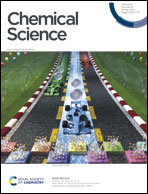Timing matters: pre-assembly versus post-assembly functionalization of a polyoxovanadate–organic cuboid†
Abstract
The pre-assembly and post-assembly approaches in the functionalization of a polyoxovanadate–organic cuboid, [{V6S}8(QPTC)8{V3}2]10−, are discussed. We have shown that the two pathways have led to distinctly different systems, with either an expanded or contracted interior void space, when phenylphosphonate is introduced at different stages of the self-assembly. One leaves the cuboid framework largely intact, whereas the other results in a compact, twisted cuboid. Kinetic factors will have to be considered in the equilibrium of these complex processes. Furthermore, the exceptional stability of these polyoxometalate–organic systems facilitates mass spectrometric characterization, which confirms the composition of the complexes and also indicates that the methoxide groups on the vanadium cluster nodes are labile. The results will help deepen the mechanistic understanding of the formation mechanisms of polyoxovanadate-based metal–organic cages and other functionalized polyoxovanadate clusters in general.



 Please wait while we load your content...
Please wait while we load your content...